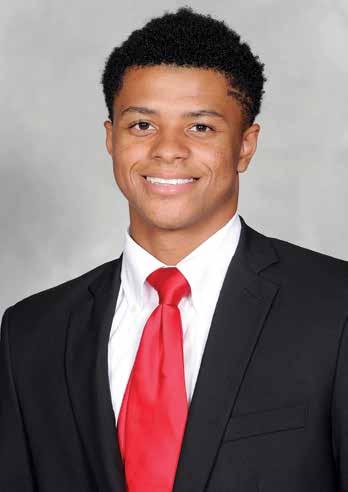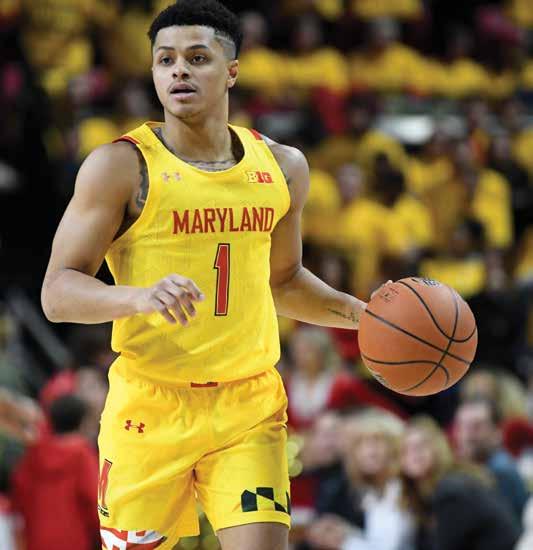
9 minute read
Towne Interview
TOWNE INTERVIEW
Talking Terps
University of Maryland hoops star Anthony Cowan Jr. answers our questions
By Tom Worgo M aryland senior point guard Anthony Cowan Jr.’s goal of winning a Big Ten title or going on a long NCAA basketball tournament run remains unfulfilled. Instead, early exits have been common. Cowan will have another shot in March, and expectations are high with Maryland ranked among the best teams in the country. Even so, Cowan will leave a lasting legacy either way. He’s on pace to finish among Maryland’s all-time top-10 scorers. It’s an impressive list that includes Len Bias, Juan Dixon, John Lucas, and Tom McMillen. All four were NBA first-round picks.
“It would be a blessing just to be able to finish with some of the best that have come through the program,” Cowan says.
The 22-year-old declared for the NBA draft in May, but decided to return to school to chase a title and improve his stock for next year’s draft. He’s been nothing but consistent at Maryland. The Bowie resident has averaged in double figures every year and earned second-team AllBig Ten honors last season after averaging 15.6 points and 4.4 assists per game.
The 5-foot-10, 180-pound Cowan has started every game in his career and is aiming to become only the second player to do that during head coach Mark Turgeon’s nine years. Turgeon has praised Cowan for his outstanding leadership with Maryland’s youthful roster.
We recently talked to Cowan about playing so close to home, his leadership role, and the lofty expectations for the 2020 Terps.
What does it mean for you to play at Maryland since you grew up in the area?
It means lot. I grew up 15 or 20 minutes away. All my friends and family come to games and see me play. I have been a huge fan of some
Maryland players and it’s definitely an honor to put on a Terps’ uniform.
Why did you return to school after declaring for the draft?
Everybody wants to get to the next level and realize their dream by playingin the NBA. I wanted to make sure I leave a lasting and winning legacy at Maryland, so people will remember my name. That’s what I am trying to do right now.
After you finish your Maryland career, how exciting will it be to play professionally?
It will be super exciting. I not only want to continue playing basketball, but also get paid for doing it. That will be a great thing and I will be very fortunate for that. I got a sense of what it’s like. My former teammates and my friends tell me about the good and bad of playing at the next level.
Maryland has been ranked in the top-10 this season. Do you and the team feel more pressure to have a breakout season?
Yes. I definitely think we invite the pressure. We are a team of competitors, so we want everyone’s best shot. I love the attention. You have to do it while it lasts. You are only going to be a college basketball player one time in your life, so you have to take advantage of it.
How would you describe your leadership style? Since you’re the team’s only senior and 10 freshmen joined the team the past two years, have you had to step up?
I am not as loud as a lot of other leaders, but I definitely talk a lot. The thing about me is I lead by example. I am a big believer in if the people you are leading see you do something and doing it with a lot of effort, they will do the same thing. A lot of the fresh- men didn’t know what they were doing, so I had to make sure I was a better leader.

How would describe your relationship with coach Mark Turgeon?
We have a great relation- ship. I have known him for a long time—ever since I was a sophomore in high school. Our relationship grows every year. He trusts me running the team.

How important has he been in your development?
Huge. He was also a small guard who had a successful college career (at Kansas). He has taught me a lot in terms of leadership, different skills, and things a player with our height should do as a point guard. He definitely has taught me a lot.
Once you finish basketball, what do you want to do for a career?
I already graduated with a degree in communications. I studied sports broadcasting. I would really like to be a broadcaster and I want to stay in sports. I think sports broad- casting is something I can do.
Do you have a pregame rou- tine?
I listen to music. That’s my routine. I usually listen to my cousin, Marty Maw, who is a Hip-Hop artist. He is from Bowie as well. I listen to him until I have to go onto the court.
What do you do to relax after a game?
I usually go back to my room and play video games. I am a big fan of video games. I also talk to my teammates. I am a real boring guy. I don’t do anything out of the ordinary. I just try to calm my body down.
What do you for fun when you are not playing basketball?
The benefit of going to Maryland is that you are close to home. It allows me to see friends and family and play with my French bulldog Drizzy.
What charities have you devot- ed time to?
One that sticks out the most to me is a food drive, called SOME (So Others Might Eat), we did in Washington, D.C., to help out the homeless. It was a great time and the team genuinely wanted to be there. I have also done Special Olympics every year I have been here. It’s a great feeling to see the kids. I can put bas- ketball away for a while.
The Key to Our Fortunes?
Shockingly Low Inflation
By Anirban Basu
It wasn’t supposed to be this good. By December 2015, the Federal Reserve had begun to ratchet up interest rates and borrowing costs in an effort to normalize monetary policy and head off emerging inflationary pressures. The prior year, unemployment had begun to dip to the point that workers across the wage spectrum were beginning to experience chunkier wage increases. The combination of ongoing job growth and faster wage increases helped perpetuate an economic expansion that had begun during the summer of 2009.
Ultimately, the Federal Reserve would raise short-term rates nine times between December 2015 and 2018. Messaging from Federal Reserve Chairman Jerome Powell and others indicated that further rate increases were forthcoming. Coming into 2019, unemployment was approaching a 50-year low—a low at which it presently sits (3.5 percent to end 2019). Based on basic economic logic, this was supposed to generate faster wage growth and additional inflationary pressure, inducing the Federal Reserve to further bolster borrowing costs. By late-2018, the average interest rate on a 30-year fixed rate mortgage had already reached 5 percent, resulting in a precipitous decline in owner-occupied housing market activity. The expectation was that 2019 would be even more problematic.
At the start of 2019, nearly a quarter of economists surveyed by the Wall Street Journal predicted that a recession would occur at some point during the year. At the time, it seemed like they were correct. The U.S. was manifesting substantial indications of both slowing and vulnerability.
The economy was adding an average of 163,000 net new jobs in the first half of the year. By comparison, the economy was adding 235,000 net new jobs over the same period in 2018. By mid-year, the economy was sending out signals of imminent recession, with the yield curve inverting and financial markets gyrating.
Then the unexpected occurred. Rather than pick up, inflation dissipated, in part because of a weakening global economy. Many factors have been at work. For instance, China began to expand at its slowest pace in three decades, laying
low the Asian economy and nearly driving Germany into recession. Economies in Africa and Latin America, increasingly reliant on Chinese investment, also began to languish.
The result was that rather than raising rates, the Federal Reserve cut rates three times in 2019. Not only did this reduce borrowing costs, it sent Wall Street into a tizzy, with the S&P 500 expanding 29 percent last year. Consumer spending continues to be robust, in part because of low interest rates on consumer and auto loans. Job growth also remains strong, inducing more consumers to spend, supporting the creation of additional employment opportunities in the process.
MARYLAND BOUNCES BACK
What a difference a year can make. At the start of 2019, the country was in the midst of the longest federal government shutdown in modern history. While the impact on the national economy was minimal, the same could not be said for Maryland, which due to its proximity to the nation’s capital, dedicates a large portion of its workforce and economy to federal agencies and government contractors.
As a result, job growth in the Free State was stagnant for much of last year as the state’s economy spun its wheels. But eventually, the state’s economy gained traction, and rather than spinning its wheels, the lo-
cal economy jolted aggres- sively forward. The pace of job growth has been akin to the adrenalin pumping beauty of burning rubber in a Ford Mustang GT. Indeed, few states added jobs as ro- bustly as Maryland during the latter stages of 2019.
The aggregate result of an awful first half of 2019 and a superior second half was that Maryland ranked right in the middle of U.S. states in terms of percentage job growth last year. Virtual- ly all of the jobs added in Maryland on net have been added in the Baltimore metropolitan area, home to large-scale redevelopments in downtown Columbia, downtown Towson, Trade- point Atlantic, and along the Baltimore City waterfront.
About Anirban Basu
Anirban Basu is Chairman & CEO of Sage Policy Group, Inc., an economic and policy consulting firm headquartered in Baltimore, Maryland.
In total, the Baltimore Metropolitan Area added 23,600 jobs in November on a year-over-year basis. This translates into an in- crease of 1.6 percent, rank- ing the region 16 th
among the nation’s 25 largest met- ro areas, tied with St. Louis, MO. That ranking puts Bal- timore ahead of other areas in the Mid-Atlantic and Northeast, including Boston (1.4 percent, 20 th
), New York (1.0 percent, t-21 st
), and Philadelphia (1.0 per- cent, t-21 st
). The Baltimore region’s unemployment rate of 3.2 percent ranks it 17 th
among the same group of metropolitan areas. In short, coronavirus notwith- standing, given Maryland’s newfound momentum, the outlook for the state’s econ- omy looks promising for at least the initial half of 2020.
In 2014, Maryland Governor Larry Hogan appointed him Chair of the Maryland Economic Development Commission. Basu earned his B.S. in foreign service at Georgetown University in 1990. He earned his master’s in public policy from Harvard University’s John F. Kennedy School of Government, and his master’s in economics from the University of Maryland, College Park. His juris doctor was earned at the University Of Maryland School of Law.












